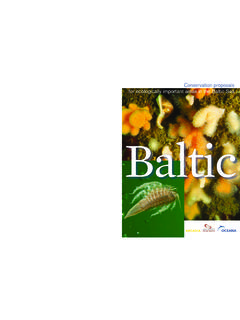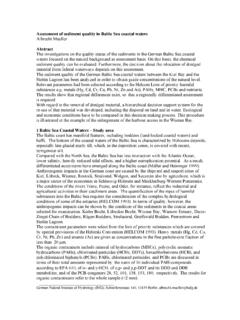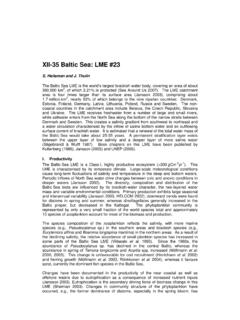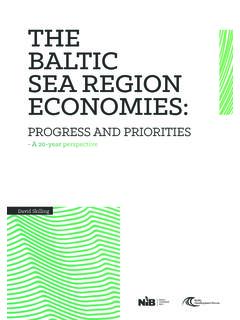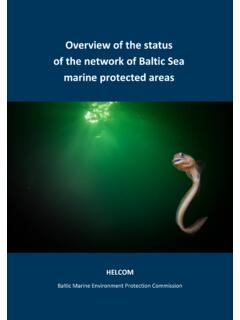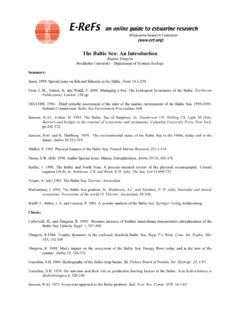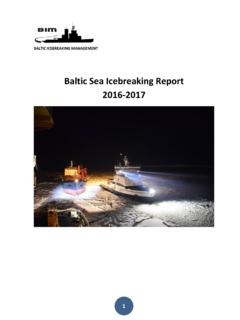Transcription of ECHOES OF ANCIENT CATACLYSMS IN THE BALTIC SEA
1 OF ANCIENT CATACLYSMS INTHE BALTIC SEAAin Haas, Andres Peekna, Robert E. WalkerThe observation that human societies are shaped by the naturalenvironment appears in the earliest treatises on cultural have focused their attention on the ordinary conditions ofthe environment (weather patterns, topography, natural resources,and other enduring features) or on recurrent events in an area(earthquakes, floods, droughts, etc.), when trying to account forlocal inhabitants distinctive customs and beliefs. Yet recent inves-tigations of ANCIENT CATACLYSMS suggest that truly extraordinaryevents can also have a great and lasting example, the recent underwater exploration of the Black Seaby Robert Ballard (2001), featured in National Geographic maga-zine, confirmed the findings of the geologists William Ryan andWalter Pitman in Noah s Flood (1998), pointing to a catastrophicflood circa 5600 BC. Salt water from the Mediterranean Sea brokethrough the Bosporus into what is now the Black Sea but was oncea glacial freshwater lake about 150 meters below present sea sudden inundation of human settlements along the old shore-line is a plausible source of accounts of a world flood: in the Sumerianepic of Gilgamesh, the Bible, and other ANCIENT example involves the massive volcanic explosion, describedby David Keys in Catastrophe (1999) that apparently split the Indo-nesian islands of Sumatra and Java around 535 It spewedenough volcanic dust into the atmosphere to darken the sun for ayear or more.
2 This led to drastic weather shifts, crop failures, plagueoutbreaks, the collapse of old civilizations, and the rise of new onesaround the separates these studies from mere ruminations is the hardscientific evidence for the CATACLYSMS . In the first case, there is anunderwater beachline in the Black Sea, below which the remains offreshwater mollusks and sediments have been found, with a radio-carbon date of 7,500 years ago. In the second case, ice core samplesfrom both Greenland and Antarctica show unusual amounts acid in the annual snow layers that fell some 1,500 yearsago, and dendrochronological analyses show a drastic reduction intree growth around the globe at the same anything of the kind happened in the BALTIC Sea area? If so,there is an opportunity to study how a scientifically verifiable cata-clysm could affect the folklore and history of an area, for manygenerations. The Finnic and BALTIC peoples, in particular, are notedfor their extensive collections of folk songs and tales, compiled mostlyin the 1800 s a product of their deep reverence for the oral tradi-tions of their ancestors and their recent and wholehearted conver-sion to literacy.
3 These peoples are also noted for their tenaciouscommitment to their homelands. Compared to most other parts ofthe world, the population of this area has been relatively stable formillennia. Archeological, linguistic, and genetic evidence all pointto continuous occupation of the shores of the BALTIC Sea since theend of the Ice Age (Uibopuu 1984: 77 78; Vahtre 1992: 8; Mark &Heapost & Sarap 1994: 241 53; Kriiska 1997; K nnap 1997, 2000;Wiik 1997; Heapost 2000; Villems 2000). Even when major shiftstook place, as with the arrival of agricultural and metalworkingIndo-Europeans, the process of change seems to have been rathergradual, with no wholesale displacement of the earlier inhabitantsby the arriving settlers. The proto-Finnic aboriginal population in-termingled with the arriving proto-Balts, which meant that loreabout ANCIENT CATACLYSMS could have been preserved through theacculturation type of cataclysm that can be proven in the BALTIC Sea area isthe sudden drainage of periglacial lakes at the end of the last IceAge.
4 As pointed out by Ryan and Pitman (1998), Baker (2002), andColman (2002), the retreat of glaciers leads to the trapping of themelting fresh water in huge lakes, which get new drainage chan-nels as the glacial retreat continues. These channels enlarge rap-idly due to erosion, which can lead to the sudden release of largevolumes of fresh water into the ocean, affecting the circulation ofcurrents and even the global BALTIC Sea experienced two such major drainage events. Thefirst was the draining of the BALTIC Glacial Lake across south-cen-tral Sweden (through the M laren Valley) in 8213 BC, leading tothe sudden lowering of the water level by 25 30 meters. Such pre-Haas & Peekna & WalkerFolklore dating was made possible by counting clay-sediment layers,and confirmed by radiocarbon dating of the freshwater and saltwa-ter strata. Then the connection with the ocean was gradually cutoff again due to isostatic rebound after Scandinavia was freed fromthe weight of the glaciers.
5 Thus, a new freshwater glacial drainagelake was born, around 7300 BC. Some centuries later, about 6500BC, this elevated Ancylus Lake broke through to the ocean acrossthe straits of Denmark. Again, there was a significant lowering ofthe water level, this time by almost 20 meters (Kessel & Punning1995).In his books H bevalge (1976) and H bevalgem (1984), Lennart Meri(the scholar, anthropological filmmaker, and diplomat who becameEstonia s first post-Soviet president) notes that another, literallyearth-shattering, cataclysm took place in the area, when a meteor-ite broke apart in the atmosphere and the pieces smashed into theEstonian island of Saaremaa to form the crater of Kaali and severalsmaller ones. He presents an intriguing argument that this had amajor impact on Estonian-Finnish mythology, folklore, involvementin iron-making and trade, etc. The date he reports for this event,600 700 , was based on radiocarbon dating of charred wood fromthe subsequent research suggests that this wood may have beendeposited later, after a much earlier formation of the crater around2000 or even 5500 Both of these datings are based onradiocarbon testing of the lowest layer of organic sediment at thebottom of Kaali Crater and of the lowest bog deposit layer holdingmeteoric debris in the nearby landscape, respectively (Tiirmaa 1994;Raukas 1995).
6 We think the date of 2000 BC is more plausible, for itis harder to account for the absence of an organic layer during thelong period from 5500 BC to 2000 BC than it is to accept the possi-bility that subsurface water flow led to the percolation of the minutemeteorite fragments into lower strata. The earlier date is also prob-lematic because the site was under water until about 3000 BC andthe crater has never yielded any marine organic matter (Tiirmaa1994: 46 47). In any case, there is strong scientific evidence that ameteorite did hit Saaremaa during the ANCIENT times, when thearea was occupied by Of Stone Age recent analyses tend to support the original date of 600 by Meri. Confirming the findings of a 2000 study byRasmussen et al., Veski (2002) reports that unusually high levels ofiridium (widely accepted as a marker of a meteorite impact) havebeen found in a bog 6 km from the Kaali crater, in association withmineral particles, charcoal, and major shifts in pollen types whichcan plausibly be interpreted as signs of impact ejecta, conflagra-tion, and disruption of vegetation, respectively.
7 The peat layers con-taining these traces have been radiocarbon-dated to 800-400 the older organic matter reported by Tiirmaa could have endedup inside Kaali crater is still a mystery, since the groundwater thatfiltered into the pit seems unlikely to have transported more thanminute particles of more ANCIENT sediments. In addition, L ugas(1996:146) finds it hard to believe that such a thick layer (6 meters)of sediment (mud, fallen trees/leaves, peat) could have formed inthe bottom of the crater only since the 7th century While weawait further studies to clear up such lingering puzzles with regardto the dating of the event, it is at least safe to say that a meteoritedid hit Saaremaa during an ANCIENT time, when the area was occu-pied by this paper, we consider how these CATACLYSMS might have af-fected the human observers of the time, and we look for possiblereferences to such events in the cultural heritage of the peoplesliving around the BALTIC Sea today.
8 For any apparent ECHOES we iden-tify, we also consider alternative explanations, such as pure coinci-dence, other disasters of a less unusual type, and diffusion of fan-tastic tales from other regions. We also consider how explanationsfor a unique event could evolve into more general themes for folktales or songs, and eventually into reinforcements of ancestor rev-erence and conventional IN THE PERIGLACIALENVIRONMENTAt the time of the sudden drainage of the BALTIC Glacial Lake (10,200years ago), the BALTIC Sea was in a barren Arctic tundra environ-ment, but by the time of the draining of Ancylus Lake (8,500 yearsago), there was a more hospitable Boreal climate, with pine forestsand hazel coppices predominating (Kessel & Punning 1995: 224 Haas & Peekna & WalkerFolklore ). Archeological finds indicate that there was human habitationin the area throughout this period. The inhabitants camped alongthe coast and made expeditions out to the few islands that pro-truded above the high water level at that time (portions of Hiiumaa,Saaremaa, and the current mainland), where they fished and huntedseals and waterfowl (Selirand & T nisson 1984: 14 21; Kriiska 1998).
9 Even if the drop in the water level took some years (about 20 in thecase of the Ancylus drainage, according to Kessel & Punning 1995:226), the human observers in the area would have seen an amazingtransformation. The shoreline would have advanced perceptibly, theislands would have grown in size, new sand bars and reefs wouldhave appeared at the surface of the water, and beds of underwaterplants would have become permanently exposed. Because the ex-posed areas were soaked with fresh water, not salt, they would havebecome habitable for plants, animals, and people in a relatively shorttime. From the perspective of the eastern side of the BALTIC Sea,where the channel of outflow would not have been visible, it wouldhave been understandable for people to think that the land wasrising rather than that the water was draining are folk songs and poems among the BALTIC Finns that seemto allude to such an event. There is a folk song from western Esto-nia (Tedre & Tormis 1999: 47), which recounts various ways in whichthe sea shore and bottom can turn into productive land:Ma laulan mere maaksi,I sing the sea into land,mere kaldad karjamaaksi,The sea s shores into grazing land,mere red heinamaaksi,The sea s edges into a hay meadow,mere p hja p llumaaksi,The sea s bottom into a plantingfield,mere kivid killingiksi!
10 The sea s stones into shillings!(Translated by A. Haas)As the point is to illustrate the power of song, it is possible that theoriginal narrator simply imagined an amazing feat, without knowl-edge that such a transformation had actually happened. Yet thedescription is quite realistic, devoid of fantastic embellishments,and it comes from the region where the water level has the great-est impact on the extent of the shoreline. In northern Estonia, muchof the shore is a high cliff; a change in the water level would changeEchoes Of Stone Age height of the cliff but not yield as much of an increase in landarea as in western is a similar song from Northern Estonia (R tel 1997: 192),but it turns the process around so that land becomes d laulan meredNow I ll sing the sea into grass,murusta,merekalda ad kalaksi,The seashore into fish,mereliiva linnastesta,The sea sand into malt,merep hja p sea bottom into a field.(Translated by A. Haas)Yet it is interesting that even here, the process ends with the seaturning into land again.
